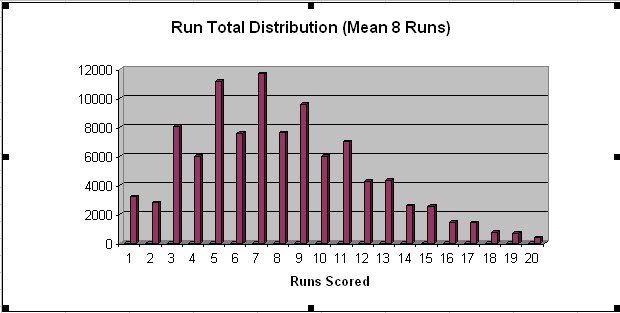The three main types of baseball game bets are the Money Line which is picking the correct team to win at the given Vegas lines, Run Lines which is a 1.5 run point spread and Run Totals which is an over/under on runs scored in a game. What I am going to go over in detail is my methodology for betting the run totals (over/under).
| Pittsburgh Pirates | o7.5 +105 |
| Houston Astros | u7.5 -115 |
In the above example the over/under is 7.5 runs. Any bet on the over pays $105 for every $100 bet. Any bet on the under pays $100 for every $115 bet if less than 7.5 runs are scored. Since the over/under is a half of a run, there are no pushes.
So what methodology do you use to determine if you should bet the over, under or make no bet at all? Obviously, you need a solid system for determining how many runs are likely to score in this game. Let's say your methodology tells you that 8 runs is the average runs scored between these two teams given the starting pitching matchup. You should bet the over right? After all, 8 is greater than 7.5. Well, not so fast. You see, runs scored per game is not distributed in a nice symmetrical bell curve. There are more games bunched around the lower scores, then more games spread out over the higher scores. It is important to know the median not the mean. Therefore you need to know the median. But how?
What you need is a simulator that can model a game accurately. And by accurately I mean it has to be proficient in modeling which team will win and how many runs will be scored. This is not easy, but given this you can simulate the game hundreds of thousands of times, keeping track of how many times each final score occurred. What you will notice is that there are a lot of one run games due to the rules of baseball (home team walk off). One run games all end in an odd number as far as the run total goes (1-0, 2-1, 3-2, 4-3 etc...).
Next you need to take that distribution output from your simulation and see how many games finished under 7.5 runs and how many finished above 7.5 runs. Then compare the likelihood of the over/under to the odds given to you from Vegas. Plug in the Vegas odds and your simulator odds into the Kelly formula and make your bet size based on that. For example, a mean run total of 8 runs is usually has a fair run total line of 7.5 runs. Which means a mean of 8 runs in most cases has an approximated median of 7.5 runs. Without the simulation you will have no idea what the median is and will not be able to make the most efficient bet.
Here is a bar chart of a 100K game simulation where the run total average was 8.08 runs per game. The y-axis is the number of occurrences and the x-axis is the run total. Notice the skew towards the lower scoring games and the difference in occurrences between the odd and even run total neighbors.

What is the fair run total line? Let's find out. Listed below are the percentage of games that would fall over/under of 7.0, 7.5, 8.0 and 8.5 runs.
| Total Runs | Over % | Under % |
| 7.0 | 55.38% | 44.62% |
| 7.5 | 49.54% | 50.46% |
| 8.0 | 45.73% | 54.27% |
| 8.5 | 41.92% | 58.08% |
Obviously, the fair over/under line would be 7.5 runs with the vig skewed slightly to the under. Did you notice that the mean total runs scored was 8.08 but the median is closest to 7.5 runs? This is why you need a simulator that kind output a distribution of scores to do this right.
In summary to bet MLB run totals with any type of success you need to have a run distribution table, letting calculate what the chances are of a game having less than or more than X number of runs. This percentage can then be plugged in to the Kelly calculator to determine your most efficient bet type.
No comments:
Post a Comment